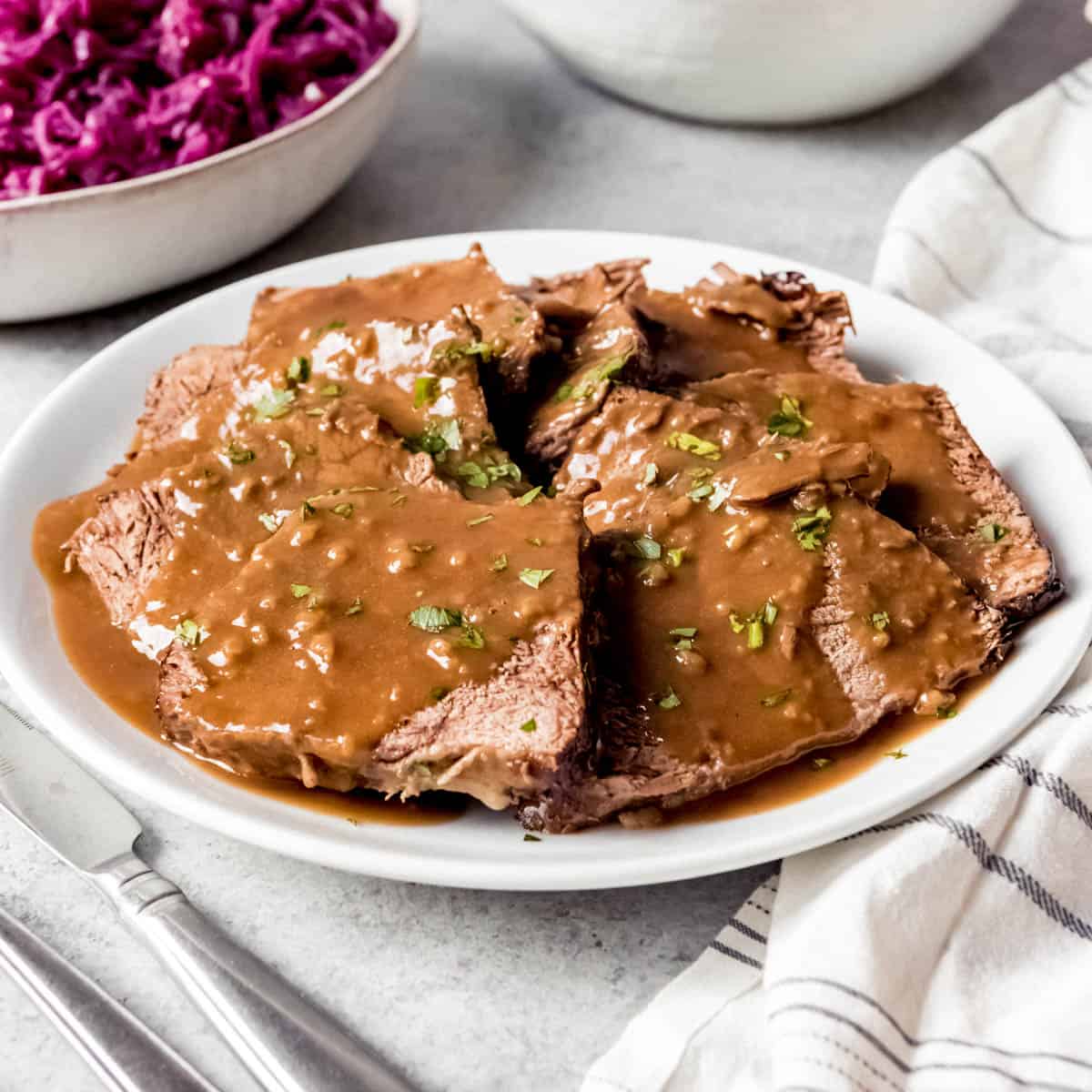The Ultimate Guide to Traditional Sauerbraten: History, Recipes, and Pairing Tips
Traditional Sauerbraten, deeply rooted in German cuisine, dates back to the time of Charlemagne over 1,200 years ago. Originally, it served as a method to preserve meat before refrigeration existed. The marination process using vinegar, spices, and herbs ensured the meat stayed edible for extended periods. Regions such as the Rhineland, Franconia, and Swabia each contributed unique variations, adding to the dish’s rich history.
Evolution Through the Centuries
The recipe for Sauerbraten has evolved over centuries. During the Middle Ages, it gained popularity among German nobility and spread through various regions, each adding their local touch. In the 19th century, immigrants introduced Sauerbraten to other parts of the world, especially the United States. Today, it remains a celebrated dish in German-American communities, continuing a legacy that connects past traditions with modern culinary practices.
Ingredients and Preparation
Key Ingredients for Authentic Flavor
Traditional Sauerbraten relies on specific ingredients to create its distinct taste. You need evenly marbled beef, typically a round roast. You can find the ingredients for the marinade in most grocery stores. These include red wine vinegar, which tenderizes the meat while providing acidity, and water to dilute the vinegar’s sharpness. Various spices ensure complexity and depth. Use whole cloves, bay leaves, juniper berries, and peppercorns, with brown sugar contributing mild sweetness. Add onions, carrots, and celery for aromatic qualities.
Marinating Process
Ensure the meat absorbs flavors by marinating it for an extended period. You need to immerse the beef in the marinade, covering it entirely. Use a non-reactive container like glass or ceramic to avoid altering the taste. Store the container in a refrigerator for at least three days, occasionally turning the meat for even flavor distribution. After marinating, remove the meat, pat it dry, and brown it in a hot pan. Then, cook it slowly in the marinade, either using a slow cooker or an oven set at a low temperature, for several hours until tender.
Regional Variations of Sauerbraten
Rhineland Sauerbraten
In the Rhineland region, Sauerbraten, a well-loved pot roast, typically includes raisins in the recipe. The inclusion of raisins adds a hint of sweetness that balances the dish’s tartness from the vinegar-based marinade. Traditionally, you can serve Rhineland Sauerbraten with potato dumplings and apple sauce, providing a sweet and savory combination. The marinade usually consists of red wine, vinegar, onions, cloves, bay leaves, and juniper berries, giving the dish its characteristic flavor.
Franconian and Swabian Differences
Franconian and Swabian regions offer distinct takes on Sauerbraten. In Franconia, the pot roast is often flavored with a darker, heartier marinade. Franconian recipes might incorporate gingerbread or Lebkuchen into the sauce, giving it a unique, spiced richness. You will often find it served with red cabbage and potato dumplings.
Swabian Sauerbraten, on the other hand, typically has a lighter and slightly less sweet profile. The marinade might include elements like vinegar, water, carrots, onions, and various spices, focusing more on the combination of herbs and vegetables to enhance the beef’s flavor. Swabian variations are often paired with Spätzle, a type of soft egg noodle, and a side of roasted root vegetables.
These regional variations, while maintaining the core tradition of marinating and slow-cooking beef, showcase the adaptability and enduring appeal of Sauerbraten, demonstrating how local ingredients and tastes shape this classic German dish.
Cooking Techniques and Tips
Slow Cooking for Optimal Tenderness
Traditional Sauerbraten benefits immensely from slow cooking. Use a heavy-bottomed pot or Dutch oven for best results. Ensure the marinated beef is submerged in the marinade, then bring it to a gentle simmer. Maintain a low heat, around 300°F, for 2-3 hours. This slow cooking process breaks down the meat fibers, resulting in a tender, flavorful roast. Check the beef periodically for tenderness by inserting a fork. If still tough after the initial period, extend cooking time in 30-minute increments until it reaches the desired texture.
Sauce Preparations and Enhancements
The sauce in traditional Sauerbraten enhances the overall taste of the dish. After removing the beef from the pot, strain the cooking liquid to separate solids from the sauce base. Return the liquid to the pot and bring it to a gentle simmer. To thicken the sauce, incorporate a slurry made from flour and water or cornstarch. Stir consistently to avoid lumps. For additional depth, consider adding gingersnap cookies, which dissolve into the sauce, providing both flavor and consistency. Adjust seasoning with salt and pepper to suit your taste. Serve the sauce generously over the sliced Sauerbraten.
Serving and Pairing Suggestions
Traditional Side Dishes
Serve Sauerbraten with authentic German sides to complete the meal. Common choices include potato dumplings, red cabbage, and spätzle. Potato dumplings, also known as kartoffelklöße, offer a soft texture that pairs well with the tender meat. Red cabbage, often braised with apples and vinegar, provides a tangy contrast to the rich flavors of the dish. Spätzle, a type of egg noodle, absorbs the gravy and adds a comforting element to the plate. Sauerkraut and mashed potatoes also make excellent accompaniments, delivering varied textures and tastes that enhance the overall experience.
Best Drinks to Complement Sauerbraten
Complement Sauerbraten with traditional German beverages. For an authentic dining experience, consider serving German beers such as Märzen, Dunkel, and Bock. Märzen offers a malty flavor that pairs well with the savory elements of Sauerbraten. Dunkel, a dark lager, provides a rich, smooth taste that complements the meat’s deep flavors. Bock, with its strong and slightly sweet profile, enhances the gravy’s complexity. For those who prefer wine, opt for a robust red like Spätburgunder (German Pinot Noir) or a dry Riesling. These wines balance the acidity of the marinade and add depth to the dish.
By choosing complementary sides and beverages, you’ll enhance the traditional flavor and create a memorable dining experience.
Conclusion
Traditional Sauerbraten offers a rich culinary experience that bridges history and flavor. Its unique marination process and slow-cooking techniques ensure a tender, flavorful dish that’s perfect for any occasion. Pair it with classic German sides like potato dumplings or red cabbage to complete your meal. Whether you enjoy it with a robust German beer or a fine wine, Sauerbraten promises to elevate your dining experience. Embrace this timeless recipe and savor a piece of culinary heritage in every bite.






